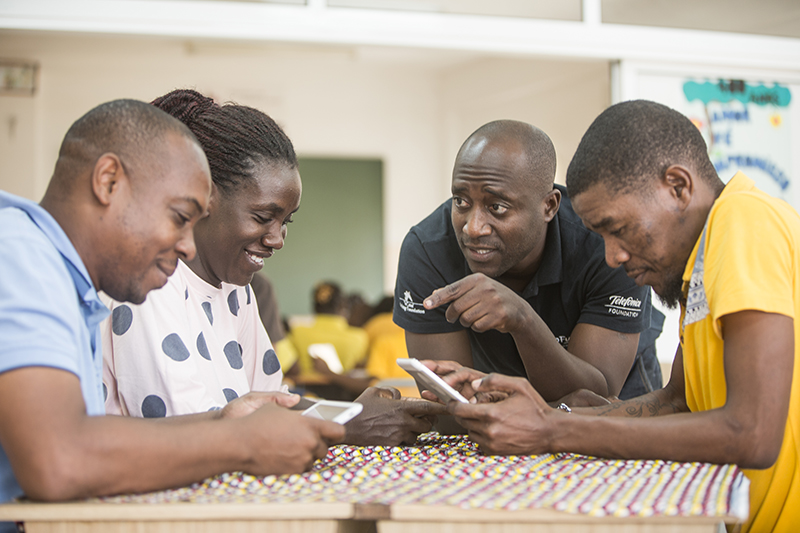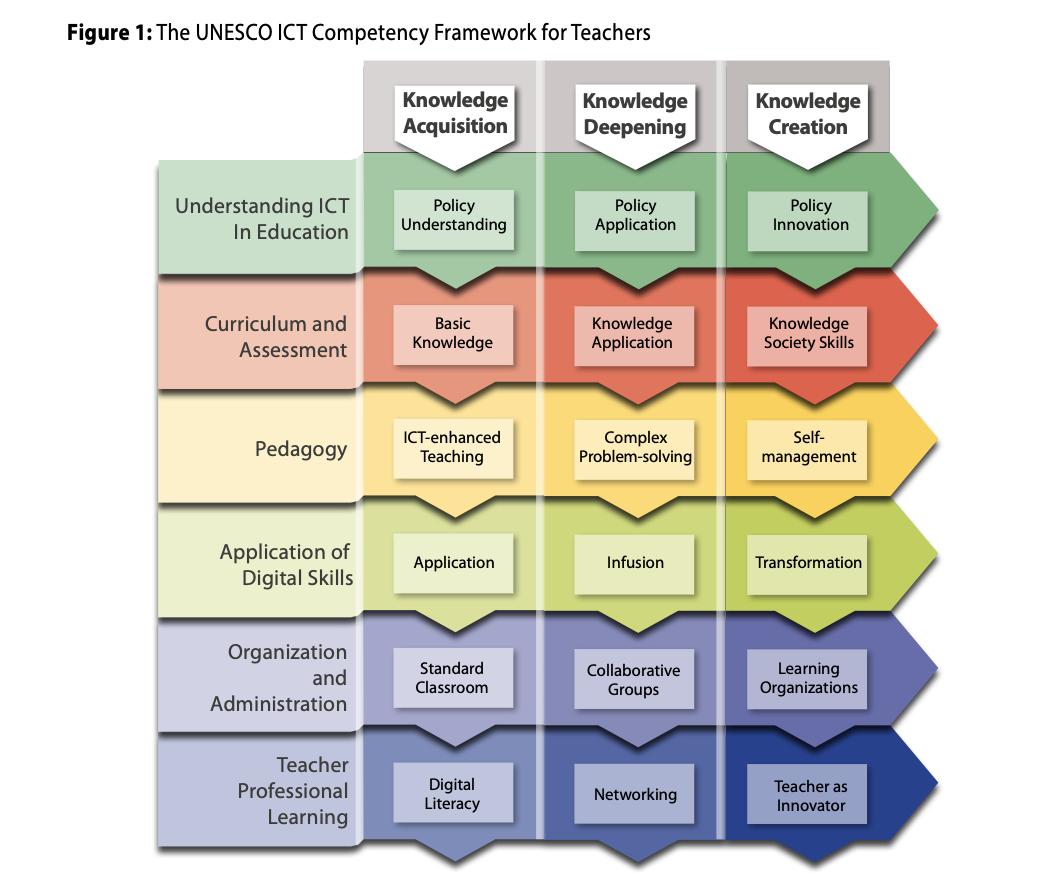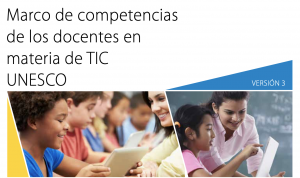The rise of Information and Communication Technologies (ICT) in the educational field led to a rethinking of the role of teachers in schools, and the need arose to further their training in order to achieve a more effective education in the development of their students’ skills. The use of ICT in education led UNESCO, together with companies such as CISCO, Intel, ISTE and Microsoft, to reflect on the skills teachers need in order to ensure an effective teaching and learning process in the classroom. They developed the third edition of the ICT Competency Framework for Teachers. The framework incorporates inclusive principles of non-discrimination and equality, and integrated recent technological advances: mobile technologies, open educational resources, artificial intelligence, and so on.
There are three editions of this Framework, the first was published in 2008, the second in 2011 and the third in 2018. Each edition presents the technologies most widely used at that time and their application in a school environment. Edition 3 of ICT Competency Framework for Teachers is a tool aimed mainly at training teachers in the use of ICT in schools. It addresses teachers, education experts, providers of teacher training courses, etc. To achieve the implementation of ICT, it is necessary to have a favourable environment. This involves government, teacher training, and professional development of teachers and school principals.
This Framework presents a total of 18 ICT competences structured into six dimensions:
- Understanding the role of ICT in education policy. Understand the role of ICT in accordance with national education policies. Teachers need to consider and work towards the goals that should be achieved.
- Curriculum and assessment. This approach involves considering the use of these digital tools, and the redefinition of specific objectives in the curriculum, as well as their related indicators and assessment proposals.
- Teaching. Teachers are encouraged to use ICT to improve teaching and learning methods. Accordingly, they acquire skills and in, a final phase, implement alternative, student-focused teaching strategies based on solving problems in a collaborative way.
- Application of digital skills. This involves integrating technology into teachers’ tasks linked to collaboration with other teachers and to planning. The most important applications at this level are e-mail, social media and word processing and presentation programmes.
- Organisation and administration. This aspect involves the management of digital tools in the school. It involves organising classrooms and the rest of the environment. The main objective is to build virtual environments to promote learning outside the classroom.
- Professional learning of teachers. To develop teachers’ digital literacy and train them professionally. By becoming producers of knowledge, they use ICT to enhance classroom practices.
In turn, each of these aspects is divided into three levels of pedagogical use of these technologies by teachers in the classroom setting:
1.Knowledge acquisition. This enables teachers to help students use ICT to learn effectively. At this level, the classroom has technological resources and ICT laboratories, ensuring equal access. This is the first phase of digital literacy.
Teachers who master the skills at this level can:
- Check whether their teaching practices are in line with national policies.
- Make pedagogical use of ICT in accordance with curricular standards.
- Choose the appropriate ICT for each of the teaching and learning methodologies.
- Define the functions of the technological tools to be used.
- Address inclusive learning through ICT
- Use technological tools for their own professional development.
2.Knowledge advancement. At this level the aim is to improve teachers’ ability to help students. Teachers use ICT to work on curricular content. This approach allows students to acquire a broad knowledge of the subjects taught, and to apply what they have learned to collaborative problem solving in the real world. It is a project-based approach to teaching and learning.
Teachers with skills at this level can:
- Implement teaching practices in accordance with education policies.
- Integrate ICT into the teaching and learning and assessment processes.
- Create project-based learning activities using ICT.
- Use the various technological tools and resources for problem solving.
- Use technology to facilitate collaborative learning.
- Interact with professional networks for the teacher’s own development.
3.Knowledge creation. This enables teachers to create knowledge, to devise activities for the classroom and to develop programmes applicable outside the school in order to achieve the goals set. New knowledge is created in order to make societies thrive. At this level, teachers will be able to:
- Reflect on educational policies and contribute ideas for improvement.
- Establish the conditions for optimal student-focused collaborative learning.
- Use ICT to promote learning by creating communities for knowledge sharing.
- Develop a technological strategy for the school.
- Share best practices on an ongoing basis, so that ICT improves schools.
Within the Framework, training plans have been developed for teachers to acquire the requisite skills.
The innovations and technologies included in this third edition of the Framework include:
- Open Educational Resources (OER): involving complete courses, videos, podcasts, course materials, etc. OER has been established as a tool that can lead to educational transformation. This is learning based on digitalised resources, easily shared and disseminated via the Internet.
- Social Media: used to facilitate interactive learning, build communities and improve pedagogical communication.
- Mobile technologies: learners make use of tablets and mobile devices to access learning platforms These devices promote productivity in the classroom and in distance learning.
- The Internet of Things: involves all those applications and devices that affect the education sector, which can work in an interconnected way, serving the scholastic needs of the education community.
- Artificial Intelligence (AI): used in the form of personalised content adapted to students using AI applications. Their biggest challenge is to adapt a learning sequence to a learner’s particularities and possibilities.
- Virtual Reality and Augmented Reality: using applications that simulate real learning environments. These provide an alternative to in-person classroom attendance.
- Macrodata: showing the connections between people and devices, with the aim of improving learning opportunities.
- Coding: allows the creation of applications and programmes through programming languages that foster the development of key competences.
- Ethics and privacy protection: as technology advances, so must the reflection on ethics and human rights. The use of ICT must take into account ethical values and safeguard users’ rights, privacy and security.
In order to facilitate the implementation of this Framework, thus supporting teachers in their professional development and in the application of new teaching and learning methodologies using ICT, in 2016 UNESCO created an open resource repository, the OER Commons. This is a search engine aimed mainly at fostering the improvement of teaching practices. It contains collections of Open Educational Resources (OER), aligned to the training needs set out in the Competency Framework. Teachers can use this tool to locate support content, as well as to connect with other educators who use ICT to improve their teaching practices.
In short, the integration of ICT into learning environments requires the right balance of pedagogy and technology in the classroom. Consequently, teacher training is a process that must take place throughout a teacher’s career, in a process commonly known as “lifelong learning”.
Check here for enabling competencies and performance indicators:
Are you involved in any initiative that aims to ensure learning continuity during the global Covid-19 crisis? Share your initiative HERE!









